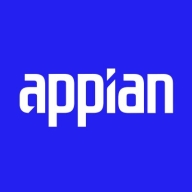

Appian and IBM Business Automation Workflow are prominent contenders in the business process management category. Appian seems to have the upper hand when it comes to rapid deployment and cost-effectiveness, while IBM excels in robust enterprise functionality.
Features: Appian provides fast low-code development, seamless integration, and intuitive process modeling. It simplifies case management and enables the creation of diverse applications. IBM Business Automation Workflow offers strong process management, customizable solutions, and a robust integration framework, making it ideal for large enterprises needing comprehensive automation capabilities.
Room for Improvement: Appian users desire more UI customization, enhanced mobile capabilities, and improved integration with enterprise tools. They also seek a scalable architecture. IBM Business Automation Workflow faces challenges in ease of use, particularly in integration and interface design. It also requires advancements in deployment agility and management of process complexity.
Ease of Deployment and Customer Service: Appian supports deployment across various environments, including public and hybrid clouds, and is praised for its deployment flexibility and responsive customer service, though some users suggest better response times. IBM Business Automation Workflow predominantly operates in on-premises settings, with customer service perceived as satisfactory but sometimes costly.
Pricing and ROI: Appian's pricing is considered competitive and adaptable, offering fast ROI for organizations looking for low-code solutions. Its flexible licensing suits diverse business needs. IBM Business Automation Workflow, while more expensive, is seen as a worthwhile investment due to its robust enterprise features, leading to ROI in time savings and process efficiency.
They see return on investment in terms of cost savings, time savings, more efficient processes, and more efficient employees.
Appian is very efficient, allowing us to build a lot of applications within a financial year, making it cost-effective.
Initially performed manually, workflows now provide a better user experience and increased efficiency.
The technical support for Appian rates as 10 out of 10 because they have a great support team.
Their customer service is responsive, and the team is very prompt for support.
The technical support is generally good.
IBM provides long-term support and maintains a traditionally good customer-vendor relationship.
If the solution is readily available to IBM support team, they provide it instantly.
On a scale of one to 10, Appian rates as a nine for scalability.
Initially, without much coding, I can easily handle five thousand records.
Appian is scalable, but it depends on how you build your applications.
We can manage the license usage and scale our environment while optimizing license use.
We are implementing load balancing and horizontal scalability.
It depends on how it has been designed and how it has been configured.
The stability of Appian would rate as nine, as it's a stable environment.
Outside of these maintenance periods, the environment is quite stable.
It has room to improve for use cases where the users are public facing, where anonymous users could come to a site and run a business workflow or interact with some data.
I would like to see more enhancement in the user interface to allow more freedom in designing the sites and pages.
If there is a very complex process that includes a lot of data transitioning and memory-centric processes, it consumes a lot of memory.
Many developments are focused on AI, LLM models, and data science.
Code management lacks merging capabilities.
IBM Business Automation Workflow could be more intuitive, with more advanced low-code features and services definition.
On the pricier side, both Appian and Pega are enterprise-level solutions, placing them on the slightly higher side.
The pricing of Appian is based on the number of users and generally ranges from 70 to 100 USD per user per month.
The price of Appian, on a competitive landscape, is a little bit on the higher side for companies, rating maybe a 6.5.
It is not a cheap license but in line with expectations for such software.
The price of IBM Business Automation Workflow is on the higher side compared to the features it offers.
The zero-code integration feature is remarkable, allowing for ease of data transfer and workflow enhancement.
Appian also utilizes AI for business users, providing a feature called process each view, enabling business users to create their own dashboards, reports, and gain insights from their data and processes using artificial intelligence.
I can create tables, perform database-related activities, and create multiple tables.
This solution has streamlined previously manual processes into orchestrated workflows.
It assisted in making users concentrate on the process flow rather than just features.
The system is fully customizable, very resilient, and fault-tolerant.
| Product | Market Share (%) |
|---|---|
| Appian | 5.3% |
| IBM Business Automation Workflow | 1.9% |
| Other | 92.8% |


| Company Size | Count |
|---|---|
| Small Business | 20 |
| Midsize Enterprise | 9 |
| Large Enterprise | 41 |
| Company Size | Count |
|---|---|
| Small Business | 6 |
| Midsize Enterprise | 3 |
| Large Enterprise | 16 |
Appian is a unified low-code platform and solution used by businesses to build enterprise applications and workflows. This product adapts to the needs of clients and the technologies they are already using to combine their data in a single workflow and maximize resources. The platform has four main components through which it transforms the work process for companies of various sizes. They are:
Appian is utilized across a diverse set of industries, including automotive and manufacturing, energy and utilities, education, financial services, telecom and media, transportation, retail, insurance, healthcare, and life sciences. The most frequent use cases of Appian are customer journey, governance, risk and compliance, operational efficiency, supply chain, distributed order management, and environmental, social, and governance (ESG) management.
Appian Features
Appian has various features that allow users to create solutions for their businesses. These features can be separated into a few groups according to function, including automation, low-code application development, and integrations and data. Some of the most frequently used features of Appian include:
Appian Benefits
The benefits of using Appian include:
Reviews from Real Users
A practice leader - digital process automation at a computer software company values Appian highly because the product is easy to develop, low-code, and has a good user interface.
Alan G., an advisory board member at Codecon VR, Appian offers a clear application life cycle, easy to learn documentation, and comes with a fundamentals course.
IBM Business Automation Workflow combines business process management and case management capabilities in one workflow solution. It integrates the capabilities of business process and case management into a single workflow offering. It unites information, process, and users to provide a 360-degree view of work to drive more successful optimized business outcomes. IBM Business Automation Workflow on Cloud provides the same capabilities that are offered in the IBM Business Automation Workflow offering, all within a ready-to-use, cloud-based environment that is hosted in IBM Cloud data centers and managed by IBM.
We monitor all Business Process Management (BPM) reviews to prevent fraudulent reviews and keep review quality high. We do not post reviews by company employees or direct competitors. We validate each review for authenticity via cross-reference with LinkedIn, and personal follow-up with the reviewer when necessary.